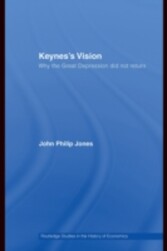
Keynes´s Vision - Why the Great Depression did not Return

von: John Philip Jones
Routledge, 2008
ISBN: 9780203939819
Sprache: Englisch
241 Seiten, Download: 1957 KB
Format: PDF, auch als Online-Lesen
2 Three signposts (p. 24-25)
Authors do not always follow the most obvious rule: "Begin at the beginning, and go on till you come to the end: then stop." (This advice comes from Lewis Carroll, the Victorian clergyman who wrote Alice’s Adventures in Wonderland.) In particular, writers on macroeconomics tend to stray from this wise counsel by fast-forwarding to advanced and complex concepts (of which there is no shortage). Then, basing their descriptions on mathematics rather than on verbal logic, such writers construct models adorned with hypothetical numbers. These models are the framework used to give quantitative values to the models’ individual components and – even more importantly – to show the connections between them.
Modern macroeconomists write the way they do for two reasons. First, they assume that their readers will already know something about the basic concepts of economics; second, the point already made that there are connections between the various elements from which the models are built.
All economic models provide a picture of the world frozen in time, and the various elements of each model are stable and in balance: in a state of equilibrium (a word borrowed from the natural sciences). Models are usually illustrated with diagrams, and are in equilibrium at the location on the diagram where the curves representing different forces intersect. A simple example will be used here and illustrated in Figure 2.1. This example is the most basic of all microeconomic models: price determination in a single industry, in which equilibrium represents the point at which the quantity of goods demanded matches the quantity supplied. This is at the crossing point of the two curves, falling demand (D) and rising supply (S). The initial price is shown as P1.
Equilibrium operates as a lodestone: an attractive force. Our example describes two separate forces, demand and supply, but an immediate imbalance can occur: Demand can exceed or fall short of supply, and supply can exceed or fall short of demand. An increase in demand for the products of a single industry (e.g. following a big reduction in direct taxation) causes price to rise: the demand curve in the diagram shifting bodily to the right (from D1 to D2). This higher price attracts an increase in supply, shown by a movement up the existing supply schedule. This movement occurs because the higher ruling price will encourage existing manufacturers to work overtime, and higher-cost producers to come into the market. The response of supply is usually rapid. The new price is shown as P2.







